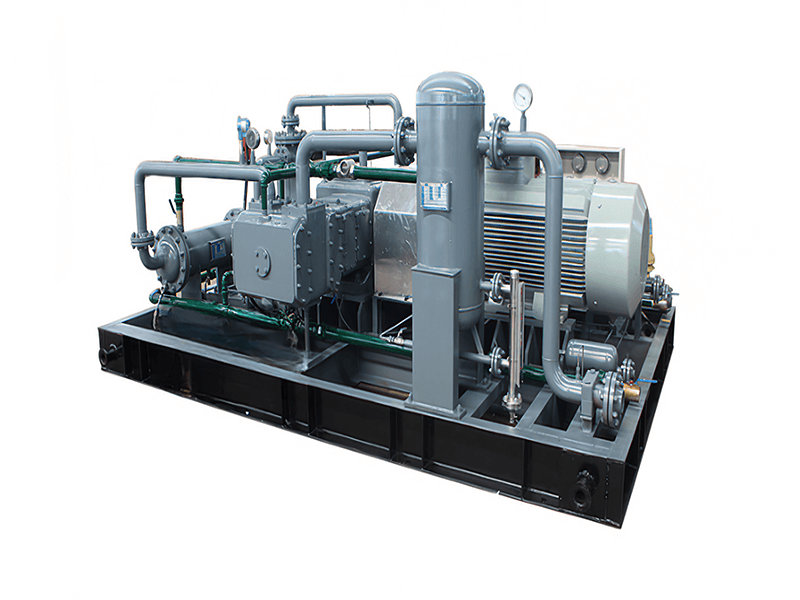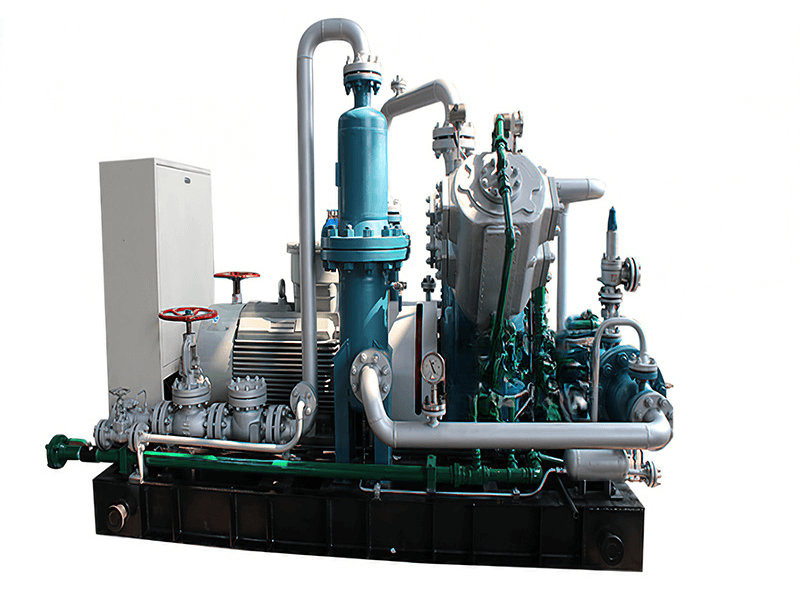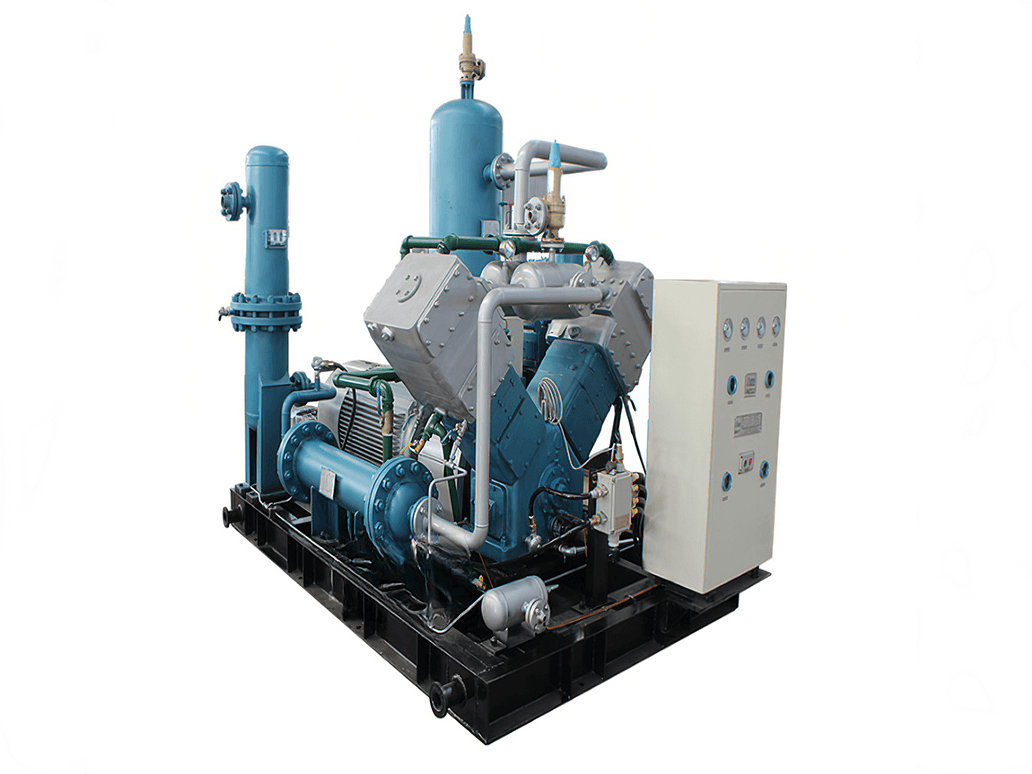Under the background of global energy structure transformation, biogas, as an important carrier of renewable energy, continues to expand its application scale. According to the International Energy Agency (IEA), the global biogas production has reached 65 billion cubic meters in 2023, of which Europe and China occupy 75% market share. However, the biogas project is characterized by complex raw material composition (40-70% methane content, containing impurities such as H₂S, CO₂, etc.) and significant pressure fluctuation (0.1-1.6MPa), which puts forward strict requirements for key equipment. With its high compression ratio (up to 1:8), wide load adaptability (30-110% of rated flow rate) and strong anti-pollution ability, piston compressor has become the core equipment for biogas purification, storage and transportation. In this paper, the technical advantages and practical value of this equipment in the field of biogas are systematically elaborated through the analysis of technical principles and typical engineering cases.
1.Analysis of the technical characteristics of piston compressors
1.1Structural design and working principle
Piston compressors use crank linkage mechanism to drive the reciprocating piston, through the cylinder volume cyclic changes to achieve gas compression. Its core components include:
Dual-stage compression cylinder: primary compression increases raw gas from atmospheric pressure to 0.4-0.6MPa, secondary compression reaches 0.8-1.6MPa.
PTFE sealing ring: H₂S corrosion resistant (concentration ≤ 3000ppm).
Water-cooled cylinder: control the temperature rise of compression process≤45℃.
Frequency conversion motor drive: 20-100Hz stepless speed regulation.
Typical working cycle includes three stages of inlet(0.1-0.15s), compression (0.05-0.08s) and outlet (0.1-0.12s), and the compression efficiency can reach 82-87%.
1.2Biogas-specific improvement technologies
Special optimization for biogas characteristics includes:
Ceramic coating technology: 0.2mm Al₂O₃-TiO₂ composite coating is sprayed on the inner wall of the cylinder, reducing the wear rate by 60%.
Three-stage filtration system: front cyclone dust removal (removes ≥5μm particles), center activated carbon adsorption (removes H₂S), and rear precision cartridge (accuracy 0.3μm)
Intelligent lubrication module: micro-lubricant injection (≤5ml/h), to avoid oil pollution.
2.Typical Application Scenario Analysis
2.1 Biogas purification system (CHP)
In the cogeneration project, the compressor boosts the crude biogas to 0.8MPa and then sends it to the membrane separation device, so that the methane concentration can be increased from 60% to more than 95%. The case of Germany E.ON shows that after adopting LMF4.5 compressor, the energy efficiency of the system is improved by 12%, and the annual operation time exceeds 8000 hours.
2.2 Preparation of Bio-CNG for Vehicle Use
When producing compressed biogas for automotive use, the compressor needs to compress the gas to 20-25 MPa. Clean Energy (USA) adopts a three-stage piston compressor, which realizes a stable operation of 5000 m³ per day through inter-stage cooling (temperature ≤40℃) and dehydration (dew point -70℃).
2.3 Biogas injection into natural gas pipeline network
The pipeline network injection project of Cadent Gas Company in the United Kingdom adopts the parallel design of double units (single unit power of 160kW), and under the condition of pressure fluctuation range of ±5%, the annual delivery of biogas reaches 12 million m3, which is equivalent to the replacement of 15,000 tons of standard coal.

3.Typical Case Studies
3.1 Agricultural Biogas Project in Henan, China
Project background: treating manure from 2000 head stockpile pig farm (daily capacity 50 tons), building 500m³ fermentation tanks
Equipment configuration: 2 sets of DW-3.2/8 piston compressors (displacement 3.2m³/min, pressure 0.8MPa)
Technical highlights:
Adopting frequency conversion control, reducing electricity cost by 18%
Integrated waste heat recovery device, preheating fermenter temperature to 35°C
Annual emission reduction of 4200 tons of CO₂ equivalent, power generation revenue of 650,000 yuan
3.2Municipal Sludge Treatment Plant in Leipzig, Germany
Project background: Treatment of municipal sludge (80% water content), biogas production of 12,000 m³ per day
Equipment: Korting SIK 550 3-stage compressor (max. pressure 25 MPa)
Operation data:
Methane loss rate <1.5%
Energy consumption per unit 0.25kWh/m³
Equipment availability 98.7%
3.3 Palm Oil Mill Wastewater Treatment Project in Thailand
Special Challenge: Treating high solids content (8-12%) biogas with H₂S concentration up to 2500ppm
Solution:
Add centrifugal separator at the inlet end of the compressor
Adoption of 316L stainless steel cylinders
Equipped with online vibration monitoring system (alarm threshold 4.5mm/s)
4.Techno-economic assessment and future trends
4.1 Full Life Cycle Cost Analysis
Calculated based on a 10-year life cycle:
Initial investment 45% (about ¥80-1.2 million)
Energy costs accounted for 30% (electricity price of ¥ 0.6/kWh)
Maintenance costs accounted for 25
Comprehensive treatment cost of about ¥ 0.15-0.2/m ³, 22% lower than the screw compressor.
4.2 Technology Development Trends
Intelligent upgrade: integrated IoT sensors (pressure, temperature, vibration) and AI diagnostic system
Application of new materials: silicon carbide ceramic piston ring (temperature resistance ≥ 400 ℃)
System integration: coupling design with PSA variable pressure adsorption device
Low-carbonization modification: dual-fuel unit driven by biodiesel
Conclusion
The successful application of piston compressors in the biogas sector has verified their technical reliability under complex operating conditions. With the EU Renewable Energy Directive (RED III) requiring the proportion of biogas to be increased to 35% by 2030, and China's 14th Five-Year Plan targeting an annual production of 10 billion cubic meters of biogas, this equipment will continue to play a key role in the fields of carbon emission reduction, energy security, and agricultural circular economy. In the future, through continuous innovation in material science, intelligent control and other fields, the energy efficiency level and application scenarios of piston compressors are expected to be further expanded.

























